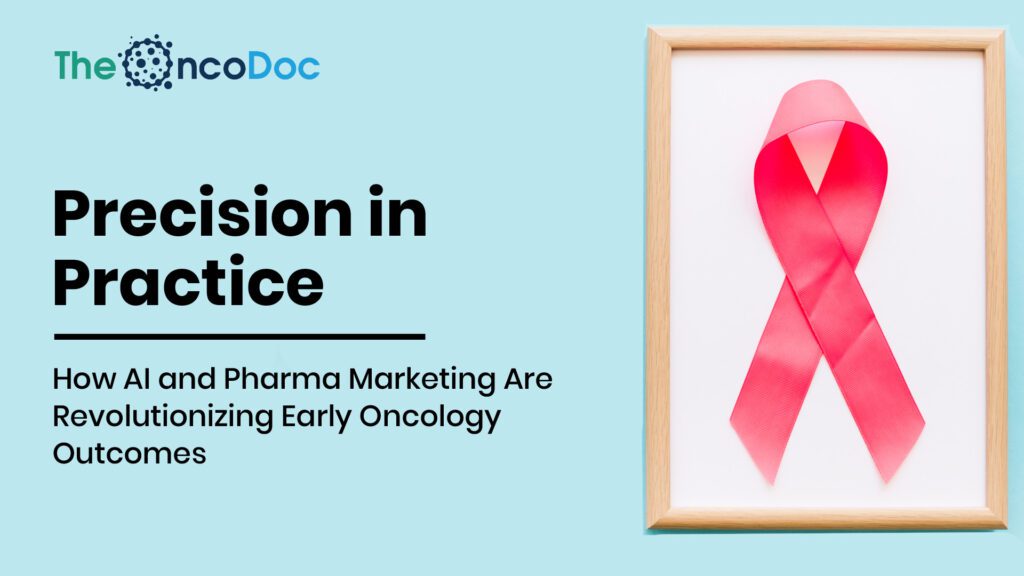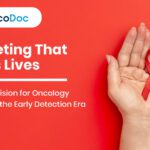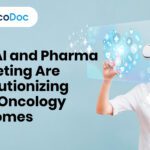Introduction: Rethinking Pharma’s Role in Cancer’s Early Chapters
Historically, pharmaceutical marketing in oncology has centered around the end of the disease journey, therapeutic positioning, clinical trial highlights, and post-diagnosis engagement with oncologists. But what if the real battleground lies upstream?
In a country like India, where nearly 70–75% of cancer cases are diagnosed in Stage III or IV, pharma brands have an untapped mandate, to intervene earlier. The challenge isn’t just about pushing a therapy; it’s about pulling the diagnosis forward. Artificial Intelligence (AI), with its ability to identify trends, predict risk, and personalize engagement, now empowers pharma marketers to extend their influence to the very beginning of the cancer care continuum.
With an emphasis on scalable awareness, predictive referral nudges, and systemic data-driven collaboration, this paper examines how AI-driven pharmaceutical marketing techniques can close gaps in early cancer detection.
Section 1: The Shift from Product-Centric to Prevention-Focused Marketing
For decades, pharma’s brand strategy in oncology has revolved around molecules. AI now enables a pivot, from molecules to moments. Pharma marketers can recognize and respond to signals that precede a diagnosis rather than waiting for it to happen.
Core Strategy Transitions:
| Traditional Approach | AI-Enhanced New Model |
| Promotion of therapy | Promotion of early screening |
| Oncologist-only engagement | Multilayer HCP + patient interaction |
| Static brand messages | Dynamic, AI-personalized education |
This evolution isn’t just ethical; it’s strategic. Brands that associate with early detection gain relevance across the full cancer journey, not just at the treatment stage.
Section 2: AI and Behavioral Data in Early Detection Campaigns
AI thrives on data, but behavioral data is where the real gold lies for early diagnosis.
By tracking how people engage with symptom content (clicks, scrolls, time spent), pharma teams can predict who’s at higher informational risk and adjust their communication accordingly.
Example Tactics:
- Use AI-based segmentation to serve “blood in stool” articles more frequently to users who searched for digestive discomfort
- Apply Natural Language Processing (NLP) to mine patient forums and detect emerging symptom chatter
- Leverage computer vision to analyze anonymized CT scan images (via partnerships) for early-stage lung nodule patterns
Section 3: Digital Epidemiology Meets Localized Marketing
What if pharma marketers could anticipate cancer detection gaps before they widened? This is precisely the promise of AI-powered digital epidemiology, enabling proactive, not reactive, interventions.
By analyzing real-time behavioral and clinical data, AI systems can now:
- Geo-map referral lags between rural and urban regions
- Heatmap symptom search trends in vernacular languages
- Identify primary care physicians frequently associated with late-stage patient referrals
These insights allow pharma to deploy targeted early detection campaigns where they’re needed most.
Insight:
Northern and eastern states exhibit significantly higher late-stage diagnosis rates, particularly Bihar and Uttar Pradesh. This evidence should guide pharma brands to concentrate symptom awareness, GP sensitization, and AI-assisted triage tools in high-burden zones. Localized, data-informed marketing isn’t just efficient, it’s essential to shifting the diagnosis curve earlier.
Section 4: Reimagining GP Engagement with Predictive Referral Nudges
Most patients’ first contact with the healthcare system is not with an oncologist, but with a general practitioner (GP).
AI allows pharma to build predictive referral dashboards, showing GPs:
- Which symptoms could flag potential malignancies
- How long similar patients waited before referral
- Real-time risk scores based on EMR patterns
Case Concept: AI Referral Nudge Tool for Cervical Cancer
- Integrated within popular GP EMRs
- Highlights “chronic discharge + pelvic pain + post-coital bleeding” as high-risk trio
- Suggests a gynaecologic referral within 48 hours
This isn’t just helpful, it can save lives.
Section 5: Using AI-Powered Chatbots to Simulate Human Guidance
AI chatbots are often used for basic customer queries. But in oncology marketing, they can serve a clinical triage role.
Advanced Chatbot Features:
- Symptom progression checklists
- Risk stratification based on age, family history, and habits
- Direct link to screening centers nearby via GPS
These bots can be deployed through WhatsApp, Telegram, or even voice-based platforms in low-literacy areas.
Implication: Language localization is critical. Pharma chatbot campaigns must go beyond English to gain rural penetration.
Section 6: Survivor-Led AI Content: Emotional Data Meets Clinical Credibility
Cancer survivors offer unmatched credibility, real voices with real impact. When combined with AI, their stories can be transformed into emotionally resonant, data-driven campaigns that shift public behavior.
Using AI-based emotional analytics, pharma marketers can:
- Auto-detect dominant themes like fear, courage, or hope in survivor narratives
- Predict engagement by examining vocal tone, facial expressions, and audience response patterns to identify the most impactful moments within the content.
· Curate personalized micro-campaigns with short, emotionally impactful videos customized for distinct cancer types and adapted to the unique cultural context of each target community.
In order to achieve maximum reach and behavior change, these AI algorithms make sure that survivor information is not only sincere but also purposefully exaggerated.
Imagine: A cervical cancer survivor shares a short video on the importance of early Pap smears. AI highlights the clip’s most compelling moment and pushes it via WhatsApp in her region. The outcome? Within a week, local screening requests increased by 40%.
This is where clinical relevance meets emotional storytelling, all enabled by AI. Pharma brands that empower survivors with smart distribution tools not only increase impact but build lasting trust in their early detection initiatives.
Section 7: Precision Public Awareness with AI-Enhanced Targeting
Traditional awareness campaigns cast a wide net. AI can target far more efficiently.
AI-Targeted Campaign Examples:
- Predictive Google Ads for people searching “mouth ulcers + white patch”
- Facebook campaigns triggered by browsing health supplements + fatigue
- Instagram Reels pushed to users in districts with high tobacco use, using AI heatmaps
This isn’t surveillance, it’s precision outreach in public interest.
Top Digital Platforms Driving Clicks on Oncology Symptom Ads
Implication: WhatsApp remains king in Tier 2 and Tier 3 markets for HCP and patient outreach alike.
Section 8: AI Nudging for HCP Behavior Change; Beyond Education
Continuous medical education (CME) builds knowledge, but changing diagnostic behavior requires consistent reinforcement. That’s where AI-driven nudging comes in, turning passive learning into proactive clinical action.
Pharma marketers can now use AI to:
- Deliver micro-content tied to each HCP’s previous CME participation (e.g., follow-up modules or symptom checklists)
- Send personalized nudges like, “Have you referred a patient with persistent hoarseness this week?”
- Optimize message tone and timing through A/B testing, adjusting reminders based on what each physician responds to best (e.g., empathetic tone vs. data-driven urgency)
These interventions feel more like helpful prompts than promotional messages, and they’re far more effective. A GP who recently completed a module on oral cancer might receive a follow-up nudge highlighting red-flag symptoms. If timed correctly, this could lead to earlier patient referrals and faster diagnosis.
AI nudging ensures that education doesn’t end with a webinar. It becomes a dynamic, ongoing conversation, tailored to clinical behavior patterns. Over time, these small, intelligent prompts can significantly shift how frontline physicians engage with early cancer detection, bridging the gap between knowledge and action.
Section 9: Oncology Toolkits for Primary Clinics; Powered by QR and AI
Many primary clinics lack oncology infrastructure. But they do have smartphones.
Pharma brands can develop AI-assisted toolkits:
- QR-coded posters linking to symptom explainer videos
- AI-powered decision trees for GPs
- Self-learning modules where AI adapts questions based on past GP performance
These turn every clinic into a mini-early-detection hub, no fancy setup required.
Section 10: Backend Analytics and Content Optimization
It’s not just about launching content. It’s about learning what works.
AI enables:
- Scroll-depth analysis of symptom landing pages
- Dynamic A/B testing of creatives
- Predictive modeling to assess what content leads to actual referrals
For instance, if oncology video A gets fewer views but more conversions than B, the algorithm boosts A automatically across relevant user segments.
Section 11: Partnering with Policy; A New Model for Scale
Pharma’s influence should not end with doctors. State governments, district health officials, and national health missions need support too.
AI-Driven Policy Tools:
- Dashboards showing screening rates by district
- Chatbot-based cancer pre-screening integrated with Ayushman Bharat
- Predictive tools that help district officers allocate mobile screening vans
This elevates pharma’s role, from vendor to visionary in cancer control.
Section 12: Real Case Study; Oral Cancer Campaign in Uttar Pradesh
Background:
Oral cancer rates among men in UP are among the highest in India due to tobacco use.
AI-Based Strategy:
- Identified low-awareness districts using Google Trends + NFHS data
- Created multilingual AI chatbots for early oral lesion screening
- Distributed WhatsApp toolkits to 6,000+ rural GPs
Results in 45 Days:
- 90,000+ chatbot interactions
- 1,500 suspected cases reported
- 21% increase in screening footfalls in government PHCs
Insight: AI didn’t replace doctors, it helped patients reach them sooner.
Conclusion: The Future of Oncology Marketing is Upstream, Intelligent, and Inclusive
Oncology is no longer just about fighting cancer, it’s about finding it earlier. Pharma marketers, armed with AI, have the opportunity to become facilitators of timely diagnosis and better outcomes.
The winning brands of tomorrow will be:
- AI-literate
- Community-integrated
- Outcome-obsessed
From dynamic WhatsApp symptom bots to precision GP nudges and collaborative dashboards, the roadmap is clear: AI can elevate pharma marketing from promotional noise to public health infrastructure.
Final Words: Marketing with a Mission
In the fight against cancer, every day matters. The earlier it’s found, the higher the chance of survival. AI is not here to replace intuition or empathy, it’s here to enhance it at scale.
Pharma marketing, when powered by AI and guided by purpose, becomes more than a commercial tool, it becomes a life-saving ecosystem.
Let the era of algorithmic altruism begin.
The Oncodoc team is a group of passionate healthcare and marketing professionals dedicated to delivering accurate, engaging, and impactful content. With expertise across medical research, digital strategy, and clinical communication, the team focuses on empowering healthcare professionals and patients alike. Through evidence-based insights and innovative storytelling, Hidoc aims to bridge the gap between medicine and digital engagement, promoting wellness and informed decision-making.



